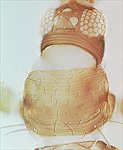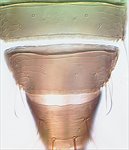
minor antenna

minor head & pronotum

minor pro, meso & metanota

minor tergites VII-IX

minor sternites IV-VI

minor fore wing
Generic diagnosis
Female macropterous. Head wider than long; maxillary palps 3-segmented; eyes without pigmented facets; ocellar setae I present; setae III long; four pairs of postocular setae. Antennae 8-segmented; segment I with paired dorso-apical setae; III and IV with elongate apex, sense cones forked; III–VI with rows of microtrichia; V with three sense cones. Pronotum with two pairs of long posteroangular setae; three pairs of posteromarginal setae. Mesonotum with median pair of setae near posterior margin; anteromedian campaniform sensilla present. Metanotum reticulate medially; median pair of setae at anterior margin; campaniform sensilla present. Fore wing with two almost complete rows of setae; clavus with five veinal and one discal setae; posteromarginal fringe cilia wavy. Prosternal ferna weakly divided; basantra membranous, without setae; prospinasternum broad and transverse. Mesosternum with sternopleural sutures complete; endofurca with spinula. Metasternal endofurca without spinula. Tarsi 2-segmented. Tergites with setae S1 wide apart; II–VIII with complete craspedum; VIII usually with ctenidium-like row of microtrichia anterior to each spiracle; IX with two pairs of campaniform sensilla; MD setae wide apart; X with short split. Sternites II–VI with lobed craspedum; III–VII with three pairs of posteromarginal setae, II with two pairs; setae S1 on VII in front of margin.
Biological data
Little is known about the biology of species in this genus, but minor has been taken commonly in the yellow flowers of Cassia [Fabaceae] (Masumoto, 2010).
Distribution data
Of the 10 species listed in this genus of Thripinae, seven are from Africa and the other three from tropical Asia. The single species recorded from China is widespread from India, through southeast Asia to northern Australia.
Nomenclatural data
Craspedothrips zur Strassen, 1966: 444. Type species Physothrips hargreavesi Karny 1925, by monotypy.
Ten species are currently recognised in this genus (ThripsWiki, 2020), of which only one is known from China:
minor (Bagnall, 1921: 393). (Physothrips)
Relationship data
Thripidae sub-family Thripinae: this is a diverse group involving more than 230 genera. This genus shares with Pezothrips and Ceratothripoides the presence of a pair of dorso-apical setae on the first antennal segment. It is possibly particularly related to another Asian genus, Aroidothrips, in which species exhibit sexual dimorphism of the antennae.
References
Masumoto M (2010) Key to genera of the subfamily Thripinae (Thysanoptera: Thripidae) associated with Japanese plant quarantine. Research Bulletin of Plant Protection Station of Japan 46: 25–59.
Mound LA, Masumoto M & Okajima S (2012) The Palaeotropical genus Craspedothrips, with new species from Africa and Malaysia (Thysanoptera, Thripinae). Zootaxa 3478: 49–61.
ThripsWiki (2020) ThripsWiki - providing information on the World's thrips. <http://thrips.info/wiki/Main_Page>